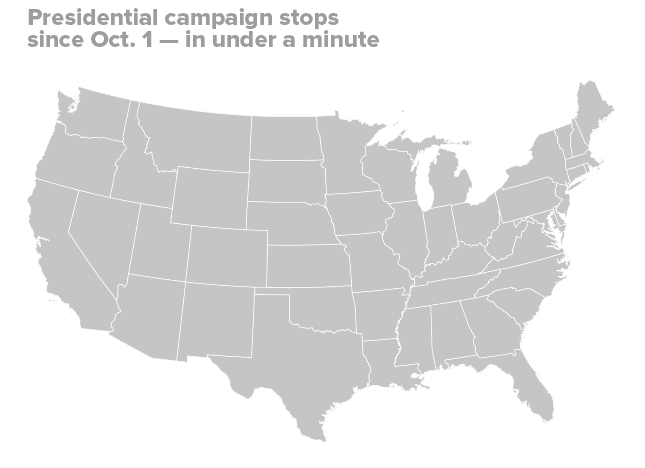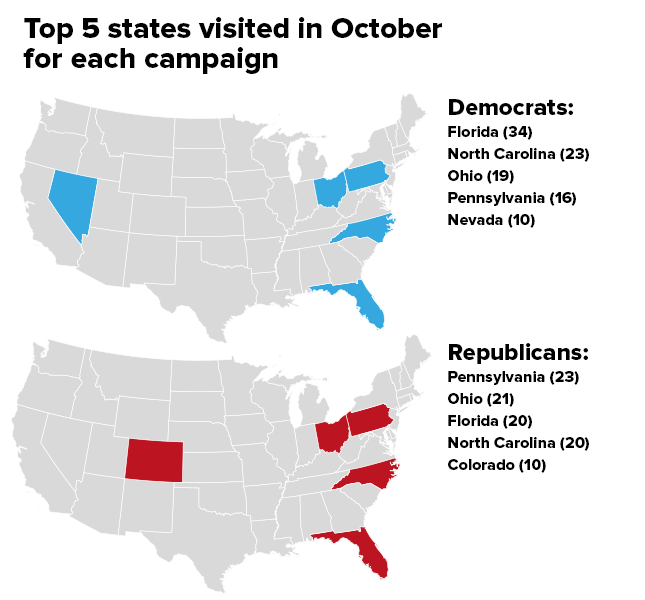Where Trump, Clinton have spent the campaign’s final month

Hillary Clinton, Donald Trump and their running mates have spent their final weeks on the campaign trail hopping between critical swing states, devoting the most time to Florida, Pennsylvania, North Carolina and Ohio, according to an analysis by The Hill.
Nearly three quarters of the 127 campaign stops Clinton, vice presidential nominee Tim Kaine and their top surrogates have made since Oct. 1 have come in those four states, according to a review of travel itineraries.
{mosads}The same four states have accounted for 84 of Trump and vice presidential nominee Mike Pence’s 146 campaign stops in the last month. On Thursday, Trump will make stops in Florida, Pennsylvania and North Carolina, while Pence ends his day in Pennsylvania.
Polls show Clinton leading by a small margin in Pennsylvania, Trump ahead by a similarly narrow gap in Ohio, and the two candidates virtually tied in Florida and North Carolina.
In all four states, the way the two campaigns are spending their time hints at their strategies — and their efforts to make up for weaknesses just days before voters head to the polls.
“In Pennsylvania, they’re going to the places where they feel like they need to boost turnout among their core supporters,” said Mark Nevins, a Philadelphia-based Democratic strategist. “For Secretary Clinton, that means Philadelphia, that means Pittsburgh. She’s ping-ponging back and forth between those two places.”
Clinton has made three stops in Pennsylvania since October 1, with three more coming: On Friday, she will rally voters in Pittsburgh. On Saturday, she will appear in Philadelphia. She will be back in Philadelphia on Monday evening, hours before polls open, for a rally with President Obama and First Lady Michelle Obama.

Only one of Clinton’s six Pennsylvania stops came in any other part of the state — an Oct. 4 rally in heavily Democratic Harrisburg.
Trump has focused his Pennsylvania appearances in suburban areas like Moon Township, outside of Pittsburgh, and Newtown, north of Philadelphia. In Ohio, he has held rallies in Delaware County, in suburban Columbus; Geneva, outside of Cleveland; and Toledo.
Those stops serve two purposes, said Jai Chabrai, an Ohio Republican and formerly a top advisor to Gov. John Kasich. The suburban rallies are meant to shore up Trump’s support with Republican voters who might not yet love him, while the more urban rallies are meant to peel off disaffected white working class voters.
“There are some places they are going, Geneva and Toledo for example, which are traditionally Democrat, but he may be able to do better than previous [Republicans] have done by virtue of the demographic from which he draws,” Chabrai said.
The two campaigns are sending their running mates largely to smaller-market communities. After the vice presidential debate in early October, Pence embarked on a three-day bus tour covering 12 small towns in Virginia, Pennsylvania and Ohio, including Gettysburg, Johnstown, Sandusky and Toledo.
“He’s out there beating the bushes with the die-hard Republicans, and they’ve got Trump trying to expand their reach into the suburbs,” Nevins said of Pence’s travel schedule.
Kaine has spent his last week in Tallahassee and Sarasota, Fla.; Taylor and Warren, Mich.; Jacksonville and Sanford, N.C.; Appleton and Madison, Wis.; and Dubuque and Des Moines, Iowa.
Both the Clinton and Trump teams have taken precious time in the last week of the campaign to make stops in territory usually friendly to the other side. Clinton rallied Arizona voters Wednesday in Tempe, while Kaine will appear at events in Phoenix and Tucson on Thursday. Trump showed up on Sunday in Albuquerque, N.M.; Pence was in Las Cruces, N.M., on Wednesday, his second stop in the normally Democratic state.

The two campaigns have spent a significant amount of time in Nevada, too. Clinton, Kaine and their top surrogates have made ten stops in the Silver State over the last month, while Trump and Pence have parachuted in eight times.
Clinton and state Democratic Parties across the country have invested far more in the on-the-ground field operations necessary to turn out voters than have Republicans. Clinton has relied on her three most prominent surrogates — President Obama, First Lady Michelle Obama and Vice President Joe Biden — to rally voters in states where the campaign is banking on strong turnout among early voters.
Obama will have made five stops in Democratic bastions in Florida by the time the campaign ends; he has rallies Thursday in Miami and Jacksonville. Biden was in Tampa and Palm Beach Gardens on Wednesday. Last week, Michelle Obama made a stop in Winston-Salem, N.C., where strong Democratic performance among early voters is key to the Clinton campaign’s chances of success.
The Obamas and Biden will have made eight stops in both Florida and North Carolina in the final month, another five in Ohio, four in Nevada and three in Pennsylvania. Michelle Obama also traveled to New Hampshire and Arizona.
Other swing states are getting less attention this year. In Virginia, Republicans have made just six stops in the last month before Election Day, while Democrats have stopped there just twice. By comparison, Obama and Biden stopped in Virginia seven times in the last month of the 2012 campaign, while Republican nominee Mitt Romney and his running mate Paul Ryan visited the commonwealth 22 times.
Clinton backers have made just four stops in Iowa in the last month, as polls show Trump leading. Republicans have been in Iowa six times. Republicans have made a late push in Wisconsin, where Trump and Pence have stopped six times; Democrats have dispatched Kaine to Wisconsin twice.
And Republicans are making a concerted push to win in Colorado, where polls show Clinton leading: Trump has visited the state seven times in the last month, and Pence another three, while Clinton and Kaine have made only a single stop each.
Copyright 2023 Nexstar Media Inc. All rights reserved. This material may not be published, broadcast, rewritten, or redistributed.

